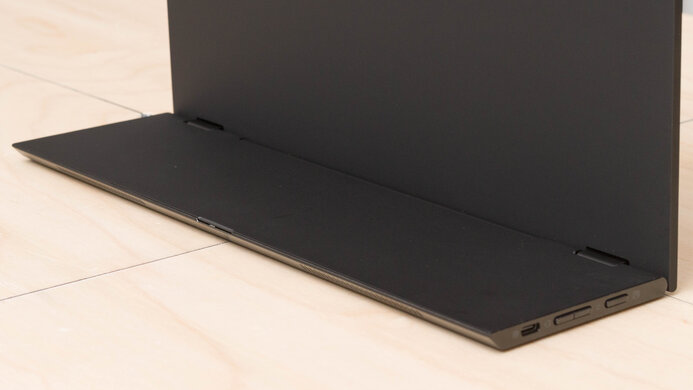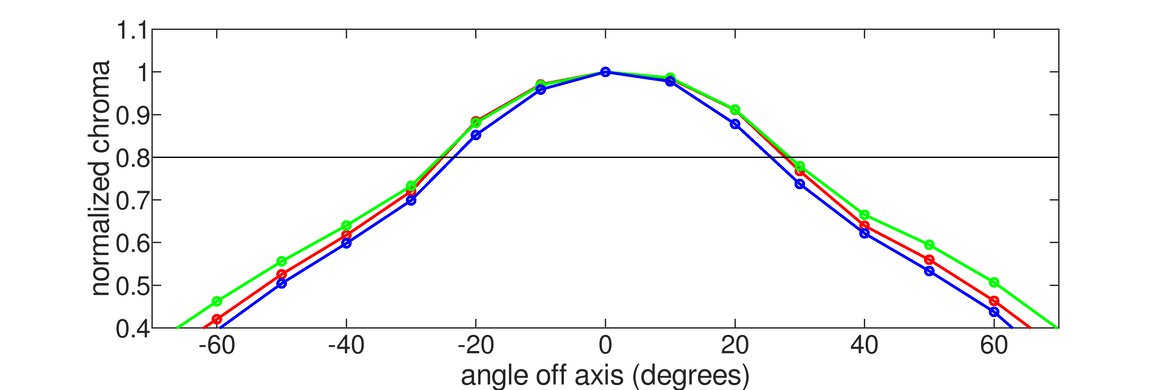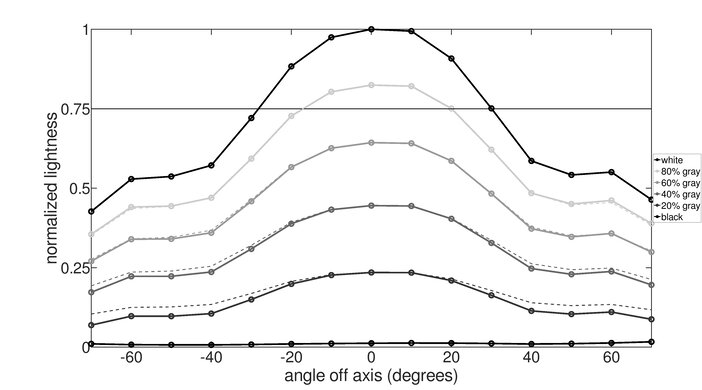The Lenovo ThinkVision M14 is a decent portable monitor. It's designed to be used as a secondary monitor when connected to a laptop, so it's limited in the number of inputs and features. There are only two USB-C inputs, so you need a laptop that supports DisplayPort Alt Mode to use it. It has a smaller 14 inch screen, which is fine as a secondary screen, and with a 1080p resolution, it still has a high pixel density that makes images look sharp. The IPS panel has fairly wide viewing angles, but that means it has a low contrast ratio, so it's not a good choice for use in dark rooms. Being a portable monitor, it doesn't offer much in terms of ergonomics, but you can tilt it, and there's a small height adjustment stand so that you can make the screen even with your laptop.
Our Verdict
The Lenovo ThinkVision M14 isn't bad for most uses. It's a portable monitor designed to be used as a secondary screen to your laptop, so it doesn't have as many features as most desktop monitors. It delivers clear text thanks to its high pixel density, but the 14 inch screen may not be big enough to open multiple windows side-by-side. It doesn't support HDR, and it's not good for gaming because it's limited to a 60Hz refresh rate and has slow response times that make motion look blurry.
- High pixel density results in crisp images and text.
- Fairly wide viewing angles.
- Decent reflection handling.
- Doesn't get bright enough to fight a lot of glare.
- Slow response times makes motion look blurry.
- Low native contrast ratio; blacks look gray.
The Lenovo ThinkVision M14 is decent for office use. It's designed to be a secondary monitor on the go, so it's limited on inputs, and you need a USB-C connection for it to work. Even though it has a smaller 14 inch screen and 1080p resolution, it delivers clear text due to its high pixel density. It has okay brightness and decent reflection handling, but it's best to avoid using it in bright rooms.
- High pixel density results in crisp images and text.
- Fairly wide viewing angles.
- Decent reflection handling.
- Doesn't get bright enough to fight a lot of glare.
- Limited to a 14 inch screen.
The Lenovo ThinkVision M14 is mediocre for gaming, mainly because it's not designed for this use. It has slow response times, so motion looks blurry, and it's limited to a 60Hz refresh rate with no variable refresh rate (VRR). It's limited on inputs, and you need a laptop or PC with a USB-C input to connect to the monitor.
- Very low input lag.
- No VRR support.
- Slow response times makes motion look blurry.
- Low native contrast ratio; blacks look gray.
The Lenovo ThinkVision M14 isn't bad for watching multimedia content. The 14 inch screen isn't very big, but it still has a 1080p resolution, and images look sharp due to its high pixel density. It has fairly wide viewing angles, so it's a decent choice for sharing your screen with someone else. However, it has a low contrast ratio that makes blacks look gray when viewed in the dark.
- High pixel density results in crisp images and text.
- Fairly wide viewing angles.
- Decent reflection handling.
- Doesn't get bright enough to fight a lot of glare.
- Limited to a 14 inch screen.
- Low native contrast ratio; blacks look gray.
The Lenovo ThinkVision M14 is okay for content creators. The 14 inch screen and 1080p resolution are good enough to use as a secondary screen because it has excellent text clarity. It has fairly wide viewing angles if you quickly need to share your screen with someone, but it may not be good enough if you need to see accurate colors. It has okay peak brightness for use in moderately-lit rooms, but it doesn't get bright enough to fight glare.
- High pixel density results in crisp images and text.
- Decent reflection handling.
- Doesn't get bright enough to fight a lot of glare.
- Limited to a 14 inch screen.
The Lenovo ThinkVision M14 doesn't support HDR.
Check Price
Differences Between Sizes And Variants
We tested the Lenovo ThinkVision M14, which is only available in this 14 inch size. If you notice that your M14 is different from ours, let us know and we'll update the review. Keep in mind that some tests, like gray uniformity, can vary between units.
Our unit was manufactured in December 2020, and you can see the label here.
Popular Monitor Comparisons
The Lenovo ThinkVision M14 is a decent portable monitor. It's a good secondary monitor for your laptop for use on the go, and the smaller screen helps it produce sharp text thanks to the high pixel density. The tilt on the stand is convenient to place the screen in an ideal viewing position, which is an advantage over the Lepow Z1 Gamut. However, it's limited on inputs, and you need to make sure your laptop supports DisplayPort Alt Mode before getting it. If you don't need its portability, it's better to go for any regular desktop monitor.
See our recommendations for the best budget monitors, the best office monitors, and the best monitors for a dual setup.
The ASUS ZenScreen Go MB16AHP and the Lenovo ThinkVision M14 are both portable IPS monitors. The ASUS is a bit bigger and has a built-in battery, so it doesn't need to draw power from your laptop, and it gets a bit brighter overall. However, colors look washed out on the ASUS because it has a very narrow color gamut, whereas the Lenovo has full sRGB coverage. The Lenovo only has USB-C inputs, while the ASUS can connect via Micro-HDMI or USB-A. The ASUS comes with a folio case that you can fold up to use as a stand, whereas the Lenovo's stand is a flap that also houses the inputs and controls.
The Dell S2721HGF is better overall than the Lenovo ThinkVision M14, mainly because they're for different uses. The Dell is a curved screen monitor designed with gamers in mind as it has a higher 144Hz refresh rate, VRR support, and much quicker response times. It's also a better choice for use in dark rooms because it has a much higher native contrast ratio. For well-lit rooms, the Dell gets brighter and has better reflection handling. On the other hand, the Lenovo is a portable monitor meant for on-the-go use. It has a smaller screen, resulting in a higher pixel density and better text clarity.
The ASUS ZenScreen MB14AC and the Lenovo ThinkVision M14 are 14" portable monitors with a 1080p resolution and 60Hz refresh rate. They perform similarly overall, except that the Lenovo has a much wider color gamut, so the image doesn't look washed out like it does on the ASUS. If you don't have a USB-C port on your device, the ASUS has an adapter that allows you to use it over USB-A.
The Lenovo ThinkVision M14 and the ASUS ProArt PA148CTV are nearly identical, but the ASUS is better overall. The ASUS has a much faster response time, resulting in less blur behind moving objects. The ASUS is also a bit brighter, and it's more accurate out of the box. They both have two USB-C inputs that both support DisplayPort Alt Mode, but the ASUS is a bit better for connectivity, as it also has a Micro HDMI port.

We buy and test more than 30 monitors each year, with units that we buy completely on our own, without any cherry-picked units or samples. We put a lot into each unbiased, straight-to-the-point review, and there's a whole process from purchasing to publishing, involving multiple teams and people. We do more than just use the monitor for a week; we use specialized and custom tools to measure various aspects with objective data-based results. We also consider multiple factors before making any recommendations, including the monitor's cost, its performance against the competition, and whether or not it's easy to find.
Test Results

The Lenovo ThinkVision M14 is a basic-looking portable monitor. It has an all-plastic body with thin borders on three sides. Its stand is a flap on the back that you can fold, kind of like a laptop. It's also lightweight and shouldn't be too heavy to carry around. It has a nearly identical design to the Dell C1422H.
Update 06/04/2021: There's also a kick stand to raise the screen a bit, as you can seen in this photo.
The stand is a flap on the back that also houses the inputs. It supports the monitor well unless you have the screen tilted forward, as it's a bit unstable in that position.
The Lenovo ThinkVision M14 has good ergonomics for a portable monitor, but it's still pretty limited. You can tilt the screen to your liking, but it's unstable if you tilt it forward, so we suggest having it a bit on a negative incline. It comes with two clips to attach the screen to the stand if you want to use it in the folded position. There's a tiny kick stand that you can use to raise the screen to make it even with your laptop. Lenovo advertises that you can use it in portrait mode, but it's not very useful because there are buttons on either side that would constantly actuate if you use the screen vertically. You would need something to hold it up in this position to use it properly. If you want a portable monitor that you can easily use in portrait mode, check out the ASUS ZenScreen MB14AC.
Surprisingly, there are two screw holes at the bottom of the stand that you can use to mount the screen. They aren't VESA-certified because there are only two and not four.
Since you can't remove the stand completely, we measured the 'Thickness (without stand)' with the monitor in the folded position, and the screen itself measures just 0.18" (0.45 cm). Even with the screen in an upright position, the entire monitor is small and doesn't take up much space.
The build quality is decent. It's made with fairly good-quality plastic, but because the monitor is so thin it flexes easily. Even when opening it up from the stand, the screen flexes, and the bottom bezel isn't very sturdy. It's still decent considering how small it is and should be good enough for you to carry around. You'd have to be careful if you want to put it in a bag, but it does come with a carrying case.
There's no local dimming feature. The above video is provided for reference only.
The Lenovo M14's SDR brightness is okay. It doesn't meet its advertised 300 cd/m². It should be enough to fight some glare in a room with a couple of lights, but it's not good enough for really bright rooms. It maintains its brightness consistent across different content, except small highlights are a bit dimmer, but you shouldn't notice that. If you want a portable monitor that can get brighter, check out the ASUS ZenScreen Go MB16AHP.
We tested brightness after calibration with the blue light setting disabled. There aren't any picture modes that you can change.
This monitor doesn't support HDR.
The Lenovo M14 has an IPS panel with fairly wide viewing angles. You may notice that colors start to look faded, and the screen looks darker at wide viewing angles.
The vertical viewing angles are decent. The screen looks darker, and the colors look a bit washed out when viewing from above and below, so it's best not to tilt the screen too much if you want to maintain an accurate image.
The Lenovo ThinkVision M14's gray uniformity is excellent. The edges are a bit darker, which isn't too noticeable, and there's no dirty screen effect in the center. Uniformity is even better in near-dark scenes. Keep in mind that uniformity can vary between units.
The Lenovo ThinkVision M14 has decent out-of-the-box accuracy, but this can vary between units. Colors and white balance are slightly inaccurate, but it's still not too bad. The color temperature is on the cold side, giving the image a blue tint. Also, gamma doesn't follow the target sRGB curve all that well, so most scenes are brighter than they should be. There aren't any picture mode settings, and you can only adjust the brightness and contrast settings.
The accuracy after calibration is fantastic. Any remaining inaccuracies can't be spotted by the naked eye, and the color temperature is almost spot-on with our 6500K target. Gamma follows the target almost perfectly, but some really dark and really bright scenes are slightly over-brightened. Even though it doesn't have many settings through the on-screen menu, we were still able to calibrate it through CalMan's auto-calibration function because the monitor has Display Data Channel (DDC) support. This function only works with DDC and automatically calibrated the monitor for us, and it worked very well.
You can download our ICC profile calibration here. This is provided for reference only and shouldn't be used, as the calibration values vary per individual unit due to manufacturing tolerances, even for the same model.
The Lenovo M14's SDR color gamut is excellent, significantly better than the Lepow Z1. It has full coverage of the sRGB color space used in most web content. Coverage of the Adobe RGB color space is decent, but it may not be enough for professional photo editors.
The SDR color gamut is amazing. Even though its peak brightness is just okay, it still displays bright colors well. However, it struggles to display darker colors due to its low contrast ratio.
This monitor doesn't support HDR.
This monitor doesn't support HDR.
The Lenovo M14 has no signs of temporary image retention even after displaying a high-contrast static image for 10 minutes, but this can vary between units.
The Lenovo ThinkVision M14 has great gradient handling. There's noticeable banding in the darker colors, but that's pretty standard for an 8-bit panel. If gradients are important to you, the Lepow Z1 shows almost no banding.
| Overdrive Setting | Response Time Chart | Response Time Tables | Motion Blur Photo |
| Off | Chart | Table | Photo |
| On | Chart | Table | Photo |
The Lenovo M14 has a bad response time, but that's somewhat expected for a 60Hz portable monitor. You'll notice motion blur when scrolling through long documents with the overdrive setting disabled. Enabling it improves the response time but introduces a lot more overshoot, which causes inverse ghosting behind fast-moving objects.
The Lenovo M14 has no Black Frame Insertion feature to reduce motion blur.
The Lenovo M14 is a basic 60Hz monitor without any variable refresh rate support. If you're looking for a portable monitor with better gaming performance, check out the ASUS ROG Strix XG16AHPE.
The Lenovo ThinkVision M14 has very low input lag; you shouldn't notice any delay.
Even though the 14 inch screen and 1080p resolution may seem limiting to some, it's good for a secondary screen. Also, it has a very high pixel density, even more than a 32 inch 4k monitor, so text and images look very sharp.
Each USB-C input on the Lenovo M14 supports USB 3.1. To power it up, you either need a supply with a USB-C port, or you can connect to a laptop with DisplayPort Alt Mode support. You can also use the monitor as a power passthrough, so you can connect a power source on one USB-C input and charge your source device with the other input. We don't know the exact power delivery, but it was enough to charge a MacBook. It only has USB-C inputs, and if you prefer something that also has a Mini HDMI input, check out the ViewSonic VG1655.
There aren't many features on the Lenovo M14. It has the power passthrough and a blue light filter setting to reduce eye strain, but that's it.
The power button is on the right side, and there are three buttons on the left side to control the on-screen display. Two of the buttons are for brightness, and holding the Brightness Up button allows you to change the contrast setting. Likewise, you need to hold the blue light filter button for a few seconds to access the overdrive setting. There weren't any instructions on how to do this in the user guides, and we had to find a more detailed manual online.














































